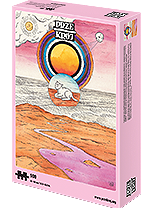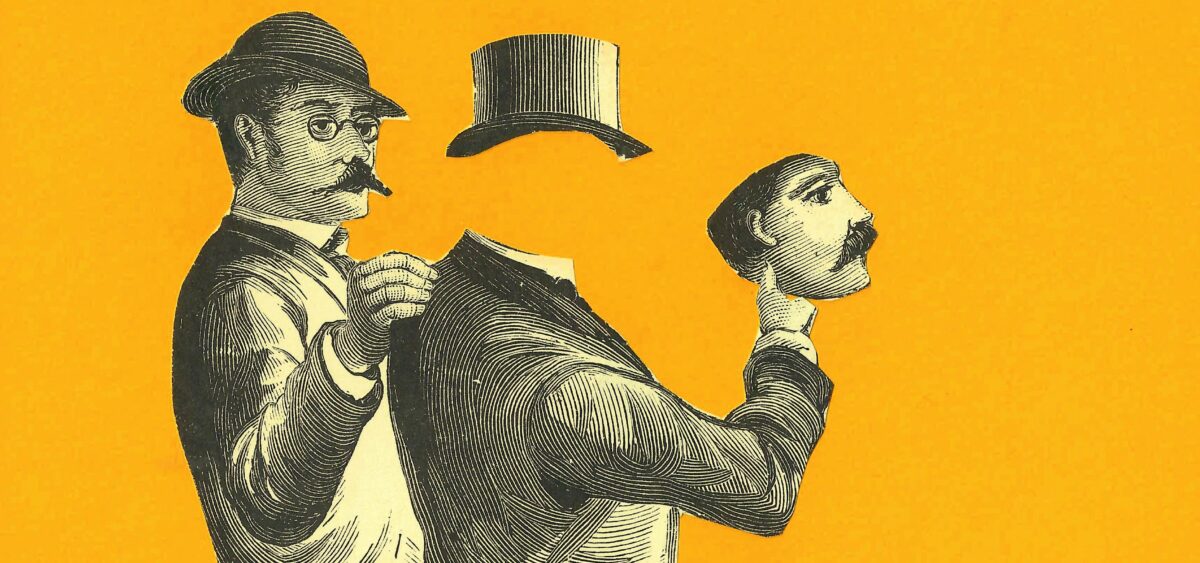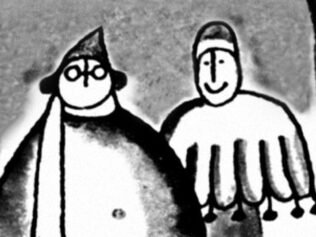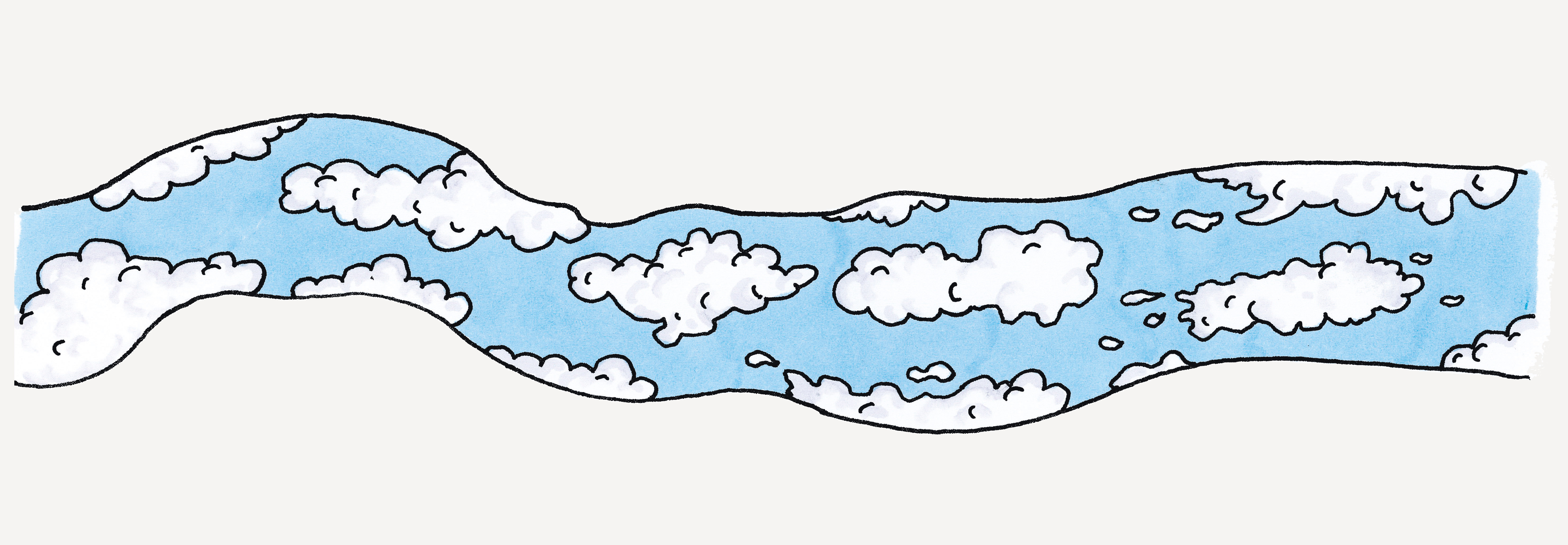
What if a tortoise had a man’s face? Or if a woman’s body was given the head of a dog? Whereas poetry can only express astonishment and talk about all these ‘what ifs’, Wisława Szymborska’s collages actually show what reality could have looked like.
A pair of lips with a stem and two leaves for the nose and eyes. The collage used on the cover of Wisława Szymborska’s 2004 Wiersze wybrane [Selected Poems] shows some characteristics of her work in general: minimalism (there are only two elements, sparsely drawn, as if almost not there; a lot is left for our imagination), a light touch, a blurring of boundaries between various spheres or worlds (in this case, between plants and people), and the ever present ‘What if?’ question (after all, the pieces of the puzzle could be arranged in many ways, and our world and the creatures in it could look differently). The collage and Szymborska’s poem “Astonishment” are companion pieces:
Why after all this one and not the rest?
Why this specific self, not in a nest,
but a house? Sewn up not in scales, but skin?
Not topped off by a leaf, but by a face?
Why on earth now, on Tuesday of all days,
and why on earth, pinned down by this star’s pin?
In spite of years of my not being here?
In spite of seas of all these dates and fates,
these cells, celestials, and coelenterates?
What is it really that made me appear
neither an inch nor half a globe too far,
neither a minute nor aeons too early?
What made me fill myself with me so squarely?
Why am I staring now into the dark
and muttering this unending monologue
just like the growling thing we call a dog?
– Wisława Szymborska in “Nic dwa razy / Nothing Twice”, translated by Stanisław Barańczak and Clare Cavanagh
Both the poem and the image are motivated by similar impulses. Whereas poetry can only express astonishment and talk about all these ‘what ifs’, Szymborska’s collages actually show what reality could have looked like. They are exercises in practical ontology.
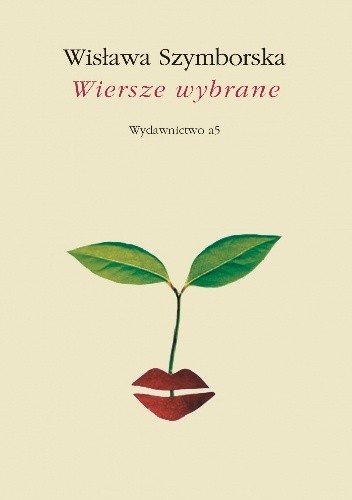
“Scratch my back, please”. Courtesy of The Wisława Szymborska Foundation
What if a tortoise had a man’s face (as in the postcard Szymborska sent to Ryszard Krynicki)? Or if a woman’s body was given the head of a dog (as in the collage presented to Wiktor Woroszylski)? The playful rearrangements of body parts reminds me of photo stand-ins from seaside resorts – you put your face in the cut-out hole, and suddenly you become a World War I bomber pilot or a Victorian era sunbather. Then you bring home a kitschy photograph as a holiday souvenir.
Even though Szymborska’s collages are primarily just humorous images made for friends, they also are perfect examples of defamiliarization (a term coined by Viktor Shklovsky, meaning to see something familiar as if it was completely new and thus regain it for ourselves, saving it from the invisibility that our habits had sentenced it to). For instance, in one of Szymborska’s collages, a figure from Diego Velázquez’s Las Meninas has been placed in an idyllic, postcard-like mountain landscape, and the clash of the two makes us reassess both the conventional postcard image and Velázquez’s painting. After all, the masterpiece has become invisible to us because of its endless reproduction in albums, on postcards or on posters. Incidentally, the juxtaposition would make a great starting point for a Hollywood comedy – let’s take a girl raised among Spanish courtiers and place her somewhere in the Swiss Alps among sheep and shepherds, and see what happens.
Another way of defamiliarizing objects is to adopt the perspective of an alien. This is what the British poet Craig Raine did in “A Martian Sends a Postcard Home”, the poem that earned his work the label of ‘Martian poetry’. However, Szymborska does not really need the point of view of an alien; if her perspective is not extraterrestrial, it is always quite extraordinary. For example, in one of her cards she uses a kitschy postcard landscape – a park, a pond with a fountain in the middle, a little bridge, a deer and an iconic red London phone box; no people around.
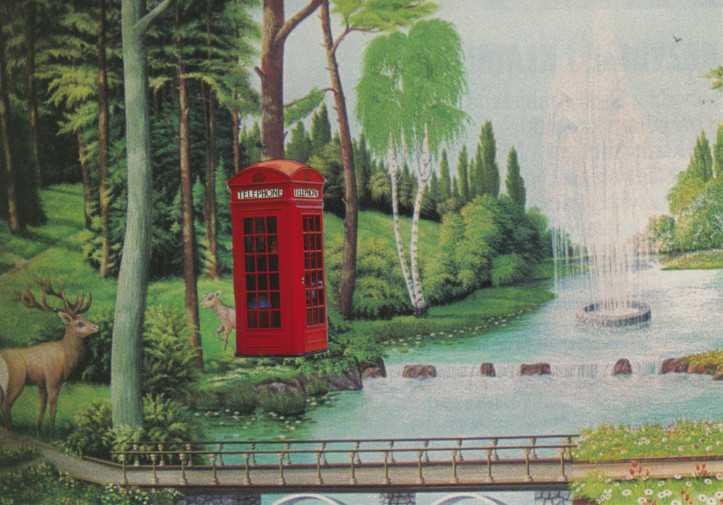
“Scratch my back, please”. Courtesy of The Wisława Szymborska Foundation
Two clichés are played against each other: on the one hand, there is the image of nature tamed and groomed by humans, and thus made more ‘beautiful’, harmless, and devoid of character (or, as Elizabeth Bishop writes in her poem “Florida”, “the poorest post-card of itself.”) On the other hand, we have the red phone box, one of the most notorious examples of British design, and a shortcut for Britishness, rendered meaningless by endless reproduction on postcards. The phone box in the middle of the park, with no one to call from it, produces a humorous surrealist effect, because the box is so out of place. At the same time, paradoxically, a phone box on a postcard is very much in place, as both the telephone and the postal service are media of long-distance communication.
The beginnings
Wisława Szymborska started making collages – or, as she called them, wyklejanki (‘cut-and-paste-cards’) – in the 1970s. Her initial impulse was due to the lack of nice postcards on the market. She would send her little creations to friends on special occasions. The largest number of cards was prepared before Christmas and New Year’s. Every December the poet would go on a several-days-long art making spree, locking herself up in her flat and announcing: “I’m not home, I’m being an artist.” She had a small flat, and while she was working on her art the place was littered with newspapers, photos, old postcards – all sorts of odds and ends that a collage artist needs. In Poland at the time, it was difficult to procure quality glue (some people made their own at home) or cardboard (friends would bring the poet postcard-size pieces from abroad) or even sharp enough scissors, so Szymborska’s endeavours had an underground DIY spirit to them. Even though she usually didn’t make each card with a particular person in mind, she chose them carefully to fit the addressee’s taste, sense of humour and the conversations she had been having with them.
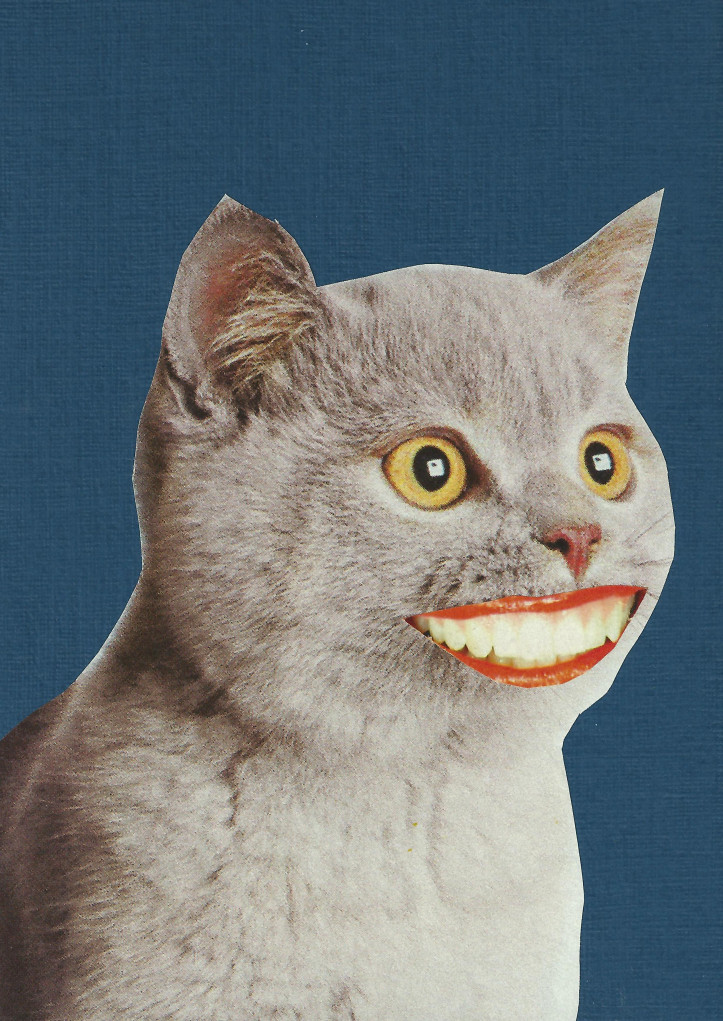
“Scratch my back, please”. Courtesy of The Wisława Szymborska Foundation
Her collages were first published, in black-and-white, in 1981, in her first American collection of poetry, Sounds, Feelings, Thoughts: Seventy Poems (translated by Magnus J. Krynski and Robert A. Maguire). Yet her art remained relatively obscure until much later, after she won the Nobel Prize, when the collages started appearing in Szymborska’s poetry collections and in art galleries. Nonetheless, their interest and popularity were mostly limited to Poland.
Although the poet herself did not treat her art too seriously, and did not plan on making it widely available, it is interesting to know that Szymborska made her debut in print as an illustrator. She drew pictures for the second edition of Jan Stanisławski’s A New English Manual (1946) and was the author of the cover illustration for Adam Włodek’s children’s book, Mruczek w butach [Puss in Boots] (1948).
What are Szymborska’s wyklejanki?
In terms of function, wyklejanki are postcards. Yet, because of their scepticism, irony and sense of the absurd, they are “incongruent with postcard aesthetics”, thus Małgorzata Baranowska prefers to call them “anti-postcards”. Common cards are mass-produced and show stereotypical images. Walter Benjamin would say that the process of mechanical reproduction causes postcard images to lose their aura, that is, the connection the original work has with the time and place of its creation, as well as the work’s individual history, including signs of wear and tear. For Benjamin then, a postcard by Szymborska would be a paradox – no longer a mass-produced object, but a postcard that only exists in one copy. Even though the elements used to make the postcards are mechanically-reproduced images and texts, by cutting them out and joining them in a new way, Szymborska reclaims for them a space in the realm of art; she gives them an aura they never had.
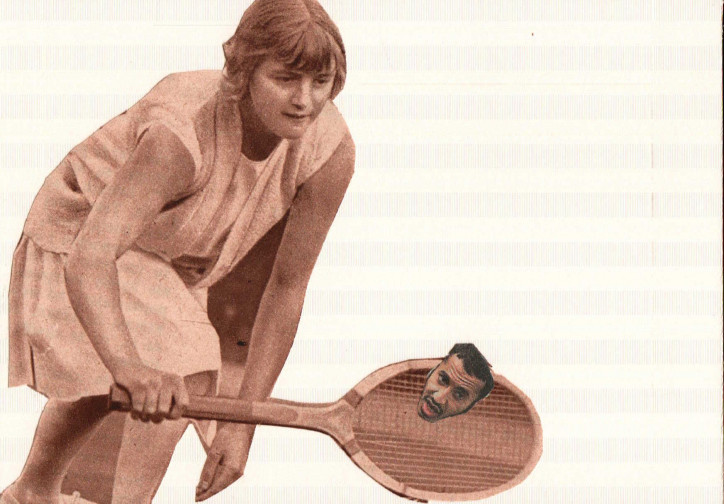
“Scratch my back, please”. Courtesy of The Wisława Szymborska Foundation
Ryszard Krynicki suggests some more contexts for reading Szymborska’s cards: Künstlerpostkarte (or ‘artist’s postcard’), for example, the work of Hannah Höch or some of the Fluxus artists; and mail art, although in Szymborska’s case the scope and ambition is much smaller.
In terms of technique, however, wyklejanki are definitely collages, and we should look at them in the context of work by such 20th-century collage artists as Georges Braque, Max Ernst and Joseph Cornell. Even more to the point is placing Szymborska’s visual art alongside that of other poets and writers who decided to go outside and beyond words. What is so tempting, I suppose, is the physical and tactile nature of the work; the process of making something with your hands, a little work of art that is potentially long-lasting, an object that affects the viewer in a more instantaneous, immediate way than words. Hans Christian Andersen drew and made numerous cut-outs, while John Ashbery is hailed as a full-blown collage artist. In his work, Ashbery likes to combine pop culture, like comic books or cartoon characters, with high art, such as paintings by Caravaggio. In this respect, Szymborska’s approach is very similar.
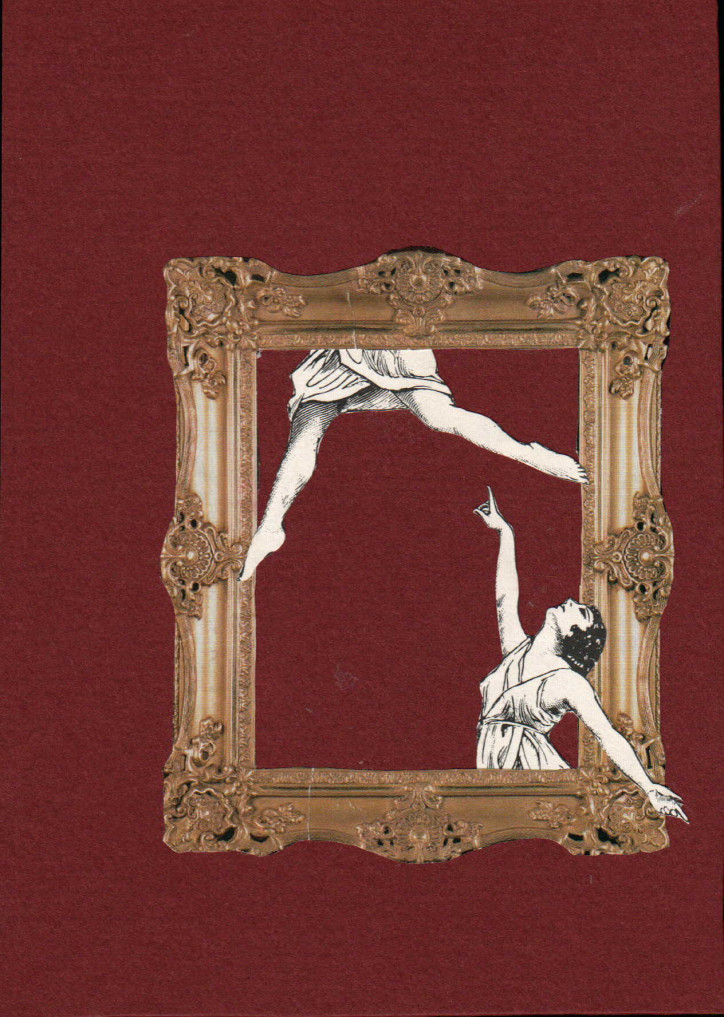
“Scratch my back, please”. Courtesy of The Wisława Szymborska Foundation
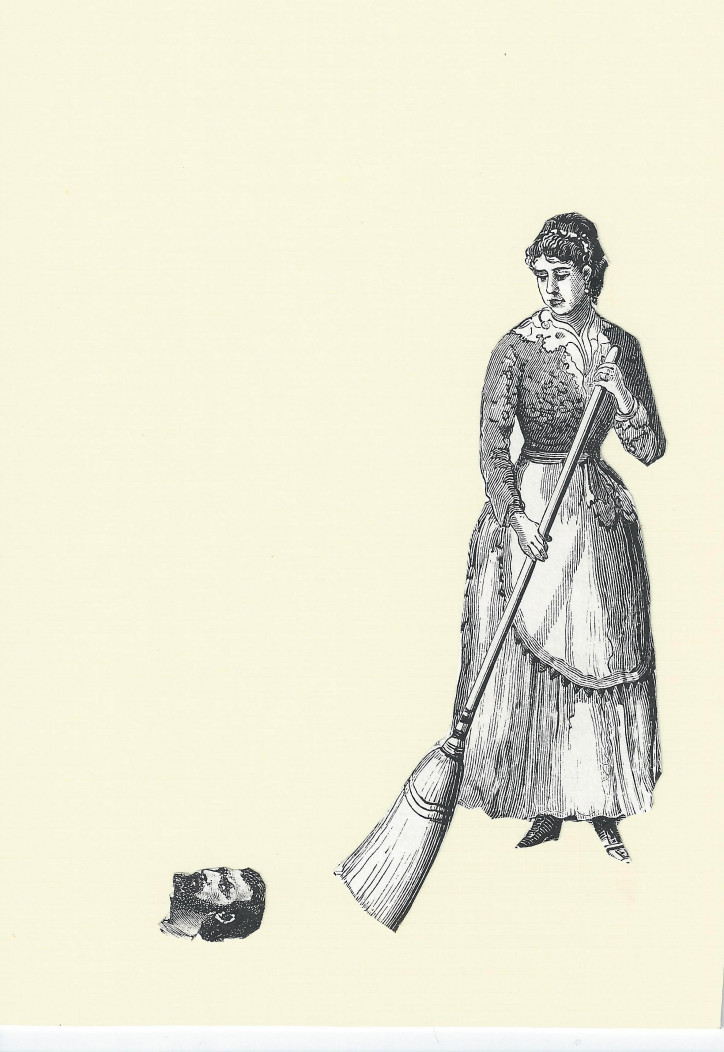
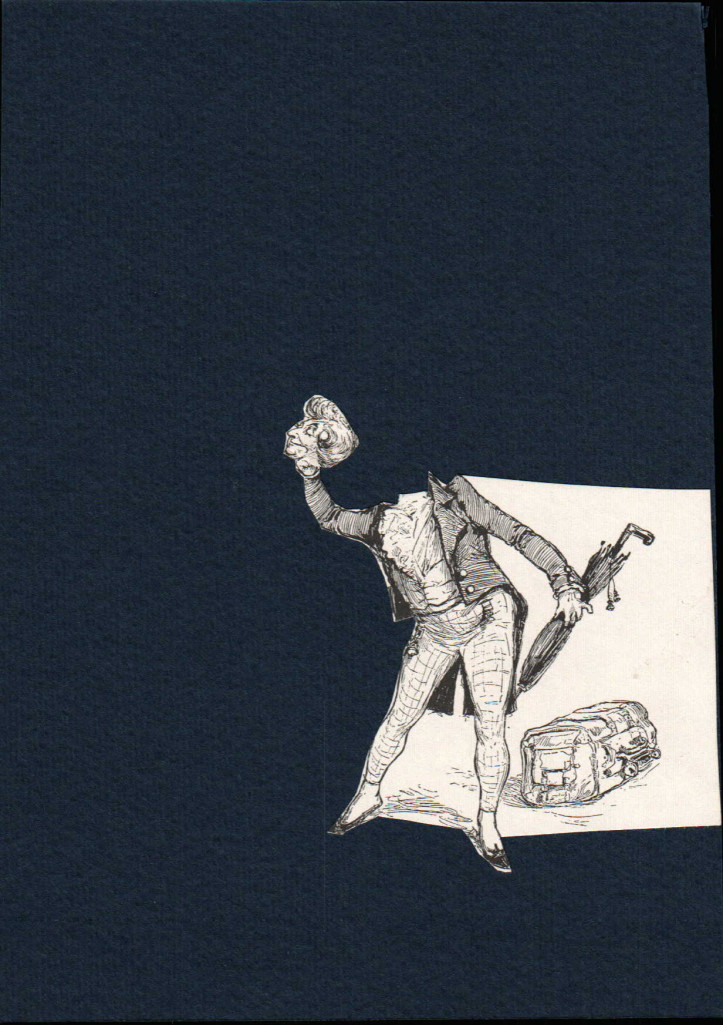
In collage, there is a fruitful tension between constraints and creative freedom. Even though the technique seems less autonomous than painting, drawing or writing (or, in general, any kind of creation from scratch), it gives the artist the freedom to manipulate reality. You can play with perspective – in one of Szymborska’s cards we see the two fingers of someone holding a bicycle with a cyclist on it. She declares in her poem “Birthday”: “I won’t catch what is distant; what’s too close, I’ll mix up.” When you use collage, you can move huge chunks of words and images across time and space and make them meet, which would otherwise be impossible. Collage is scrappy, fragmentary, and therefore a perfect medium to talk about the contemporary world; a reality so complex that no one hopes to ever see the whole picture.
Collage is a perfect vehicle for beauty as defined by Lautréamont: “[…] the chance meeting on a dissecting table of an umbrella and a sewing machine.” In the case of collage, however, what seems an element of chance, namely, the meeting of elements coming from completely different contexts, is premeditated. Elements of a collage are carefully chosen and put together to yield the most striking effects. The result is a clash of tones, styles and eras. We can be sure that, had he known collage with its unusual juxtapositions, Samuel Johnson would have been abhorred by it. The 17th-century critic is famous for defining the metaphysical conceit as “the most heterogeneous ideas […] yoked by violence together,” which is definitely not a compliment.
Kitsch
If Szymborska’s source materials were originally considered kitsch, most of them are no longer recognized as such today. Kitsch is something that wants to be taken seriously, and fails at it. There is no place for ironic distance here; kitsch is beauty gone awry. Owing to so many years gone by, the chosen fragments are now perceived as out of time. When they are put alongside other elements of a collage, they also become out of place. Szymborska’s choice of material reveals a certain nostalgia – clippings from old newspapers, art albums, catalogues showing archaic expressions, outdated manners and clothes long gone out of fashion.
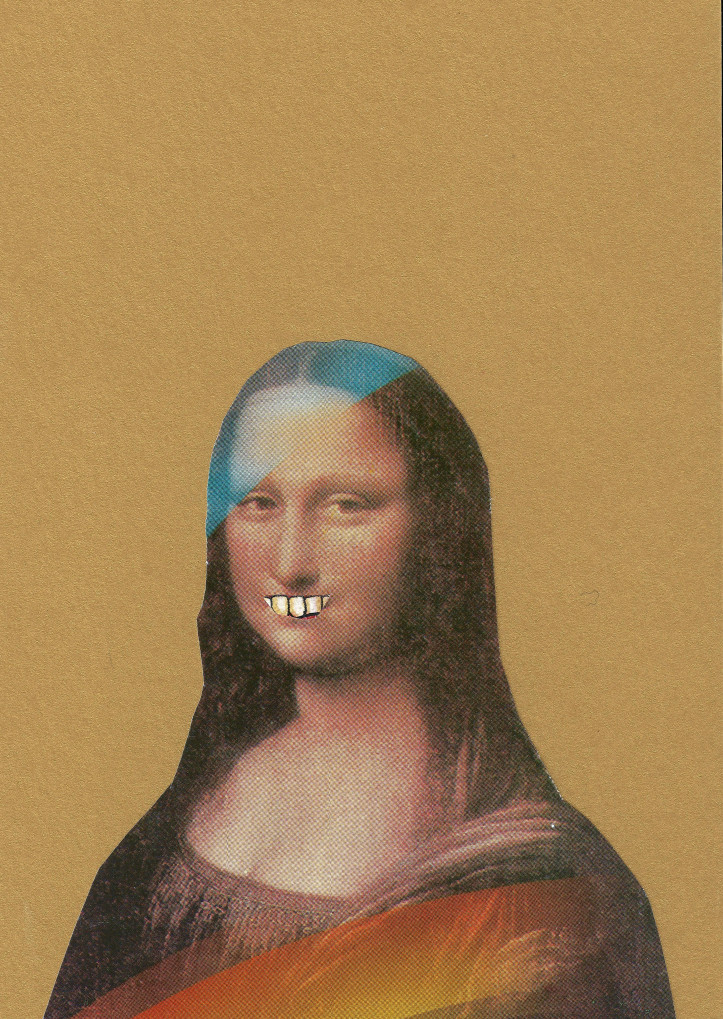
“Scratch my back, please”. Courtesy of The Wisława Szymborska Foundation
The samples of language we see offer a whole array of styles, registers and tones – pieces of advertising, newspaper articles, nonsense poetry, classified singles ads. Szymborska also had a strong predilection for Polish decadent writers with a penchant for ornate language that did not age well (it seems rather untranslatable, but mixing Swinburne with Mallarmé might give you a general idea), and for popular culture from various periods. For example, she was an avid fan of the soap opera Dynasty, where she recognized motifs from Greek mythology, recycled and made palatable for a contemporary mass audience.
A style of her own
There are significant differences between the collages. Some are merely jokes, some are doubtlessly anchored in conversations the author was having with the addressee, some are racy, and others – like a series presented to Kornel Filipowicz – indebted to surrealism and showing a great sense of composition (e.g. a column with a window on top, or a collage showing a pile of suitcases). Others still, were they made today, would have become viral internet memes – one collage shows a gentleman kneeling before a lady, with a caption saying: “Scratch my back, please.”; another is a picture of a cat baring its teeth, with the caption underneath: “She lives by three principles: never lies, / is not ashamed of her feelings / and not scared of anything.” Humour is definitely one of the characteristics that sets Szymborska’s collages apart. Only she could make a postcard of a kissing couple with the caption: “One of the causes of nasal congestion.”, or a picture of sharks with the slogan: “Splendid funerals at affordable prices.” Szymborska is an artist in her own right, and her sense of humour makes her work truly inimitable.
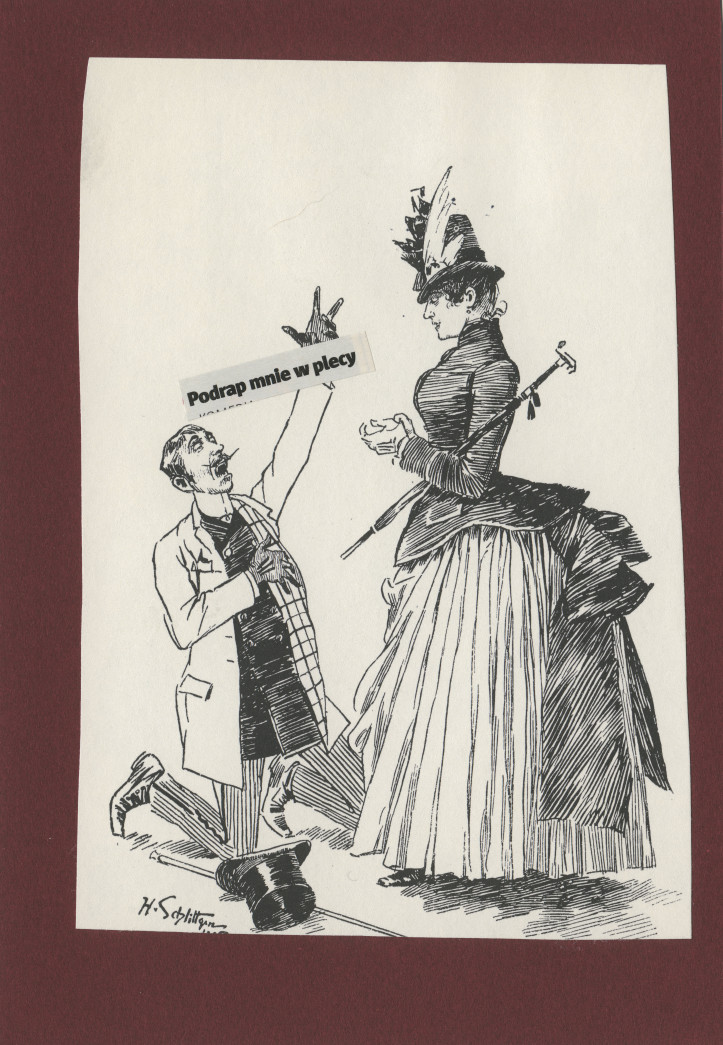
“Scratch my back, please”. Courtesy of The Wisława Szymborska Foundation

